Alejandro Lopez-Lira
Your AI, Not Your View: The Bias of LLMs in Investment Analysis
Jul 28, 2025Abstract:In finance, Large Language Models (LLMs) face frequent knowledge conflicts due to discrepancies between pre-trained parametric knowledge and real-time market data. These conflicts become particularly problematic when LLMs are deployed in real-world investment services, where misalignment between a model's embedded preferences and those of the financial institution can lead to unreliable recommendations. Yet little research has examined what investment views LLMs actually hold. We propose an experimental framework to investigate such conflicts, offering the first quantitative analysis of confirmation bias in LLM-based investment analysis. Using hypothetical scenarios with balanced and imbalanced arguments, we extract models' latent preferences and measure their persistence. Focusing on sector, size, and momentum, our analysis reveals distinct, model-specific tendencies. In particular, we observe a consistent preference for large-cap stocks and contrarian strategies across most models. These preferences often harden into confirmation bias, with models clinging to initial judgments despite counter-evidence.
FinDER: Financial Dataset for Question Answering and Evaluating Retrieval-Augmented Generation
Apr 22, 2025Abstract:In the fast-paced financial domain, accurate and up-to-date information is critical to addressing ever-evolving market conditions. Retrieving this information correctly is essential in financial Question-Answering (QA), since many language models struggle with factual accuracy in this domain. We present FinDER, an expert-generated dataset tailored for Retrieval-Augmented Generation (RAG) in finance. Unlike existing QA datasets that provide predefined contexts and rely on relatively clear and straightforward queries, FinDER focuses on annotating search-relevant evidence by domain experts, offering 5,703 query-evidence-answer triplets derived from real-world financial inquiries. These queries frequently include abbreviations, acronyms, and concise expressions, capturing the brevity and ambiguity common in the realistic search behavior of professionals. By challenging models to retrieve relevant information from large corpora rather than relying on readily determined contexts, FinDER offers a more realistic benchmark for evaluating RAG systems. We further present a comprehensive evaluation of multiple state-of-the-art retrieval models and Large Language Models, showcasing challenges derived from a realistic benchmark to drive future research on truthful and precise RAG in the financial domain.
Open-FinLLMs: Open Multimodal Large Language Models for Financial Applications
Aug 20, 2024
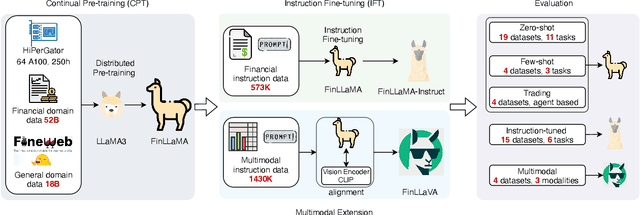
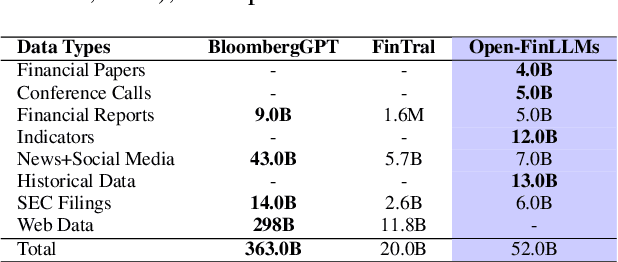
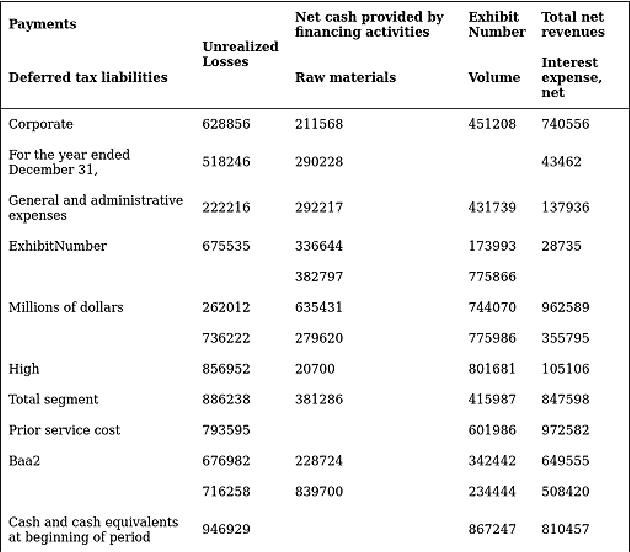
Abstract:Large language models (LLMs) have advanced financial applications, yet they often lack sufficient financial knowledge and struggle with tasks involving multi-modal inputs like tables and time series data. To address these limitations, we introduce \textit{Open-FinLLMs}, a series of Financial LLMs. We begin with FinLLaMA, pre-trained on a 52 billion token financial corpus, incorporating text, tables, and time-series data to embed comprehensive financial knowledge. FinLLaMA is then instruction fine-tuned with 573K financial instructions, resulting in FinLLaMA-instruct, which enhances task performance. Finally, we present FinLLaVA, a multimodal LLM trained with 1.43M image-text instructions to handle complex financial data types. Extensive evaluations demonstrate FinLLaMA's superior performance over LLaMA3-8B, LLaMA3.1-8B, and BloombergGPT in both zero-shot and few-shot settings across 19 and 4 datasets, respectively. FinLLaMA-instruct outperforms GPT-4 and other Financial LLMs on 15 datasets. FinLLaVA excels in understanding tables and charts across 4 multimodal tasks. Additionally, FinLLaMA achieves impressive Sharpe Ratios in trading simulations, highlighting its robust financial application capabilities. We will continually maintain and improve our models and benchmarks to support ongoing innovation in academia and industry.
No Language is an Island: Unifying Chinese and English in Financial Large Language Models, Instruction Data, and Benchmarks
Mar 10, 2024



Abstract:While the progression of Large Language Models (LLMs) has notably propelled financial analysis, their application has largely been confined to singular language realms, leaving untapped the potential of bilingual Chinese-English capacity. To bridge this chasm, we introduce ICE-PIXIU, seamlessly amalgamating the ICE-INTENT model and ICE-FLARE benchmark for bilingual financial analysis. ICE-PIXIU uniquely integrates a spectrum of Chinese tasks, alongside translated and original English datasets, enriching the breadth and depth of bilingual financial modeling. It provides unrestricted access to diverse model variants, a substantial compilation of diverse cross-lingual and multi-modal instruction data, and an evaluation benchmark with expert annotations, comprising 10 NLP tasks, 20 bilingual specific tasks, totaling 1,185k datasets. Our thorough evaluation emphasizes the advantages of incorporating these bilingual datasets, especially in translation tasks and utilizing original English data, enhancing both linguistic flexibility and analytical acuity in financial contexts. Notably, ICE-INTENT distinguishes itself by showcasing significant enhancements over conventional LLMs and existing financial LLMs in bilingual milieus, underscoring the profound impact of robust bilingual data on the accuracy and efficacy of financial NLP.
The FinBen: An Holistic Financial Benchmark for Large Language Models
Feb 20, 2024



Abstract:LLMs have transformed NLP and shown promise in various fields, yet their potential in finance is underexplored due to a lack of thorough evaluations and the complexity of financial tasks. This along with the rapid development of LLMs, highlights the urgent need for a systematic financial evaluation benchmark for LLMs. In this paper, we introduce FinBen, the first comprehensive open-sourced evaluation benchmark, specifically designed to thoroughly assess the capabilities of LLMs in the financial domain. FinBen encompasses 35 datasets across 23 financial tasks, organized into three spectrums of difficulty inspired by the Cattell-Horn-Carroll theory, to evaluate LLMs' cognitive abilities in inductive reasoning, associative memory, quantitative reasoning, crystallized intelligence, and more. Our evaluation of 15 representative LLMs, including GPT-4, ChatGPT, and the latest Gemini, reveals insights into their strengths and limitations within the financial domain. The findings indicate that GPT-4 leads in quantification, extraction, numerical reasoning, and stock trading, while Gemini shines in generation and forecasting; however, both struggle with complex extraction and forecasting, showing a clear need for targeted enhancements. Instruction tuning boosts simple task performance but falls short in improving complex reasoning and forecasting abilities. FinBen seeks to continuously evaluate LLMs in finance, fostering AI development with regular updates of tasks and models.
Dólares or Dollars? Unraveling the Bilingual Prowess of Financial LLMs Between Spanish and English
Feb 12, 2024
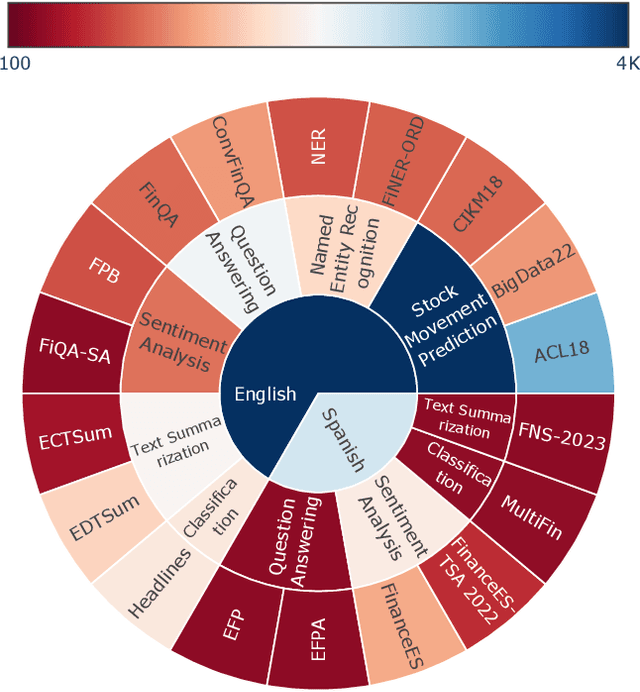
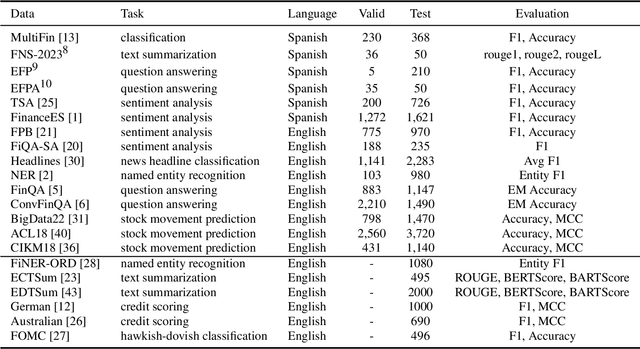
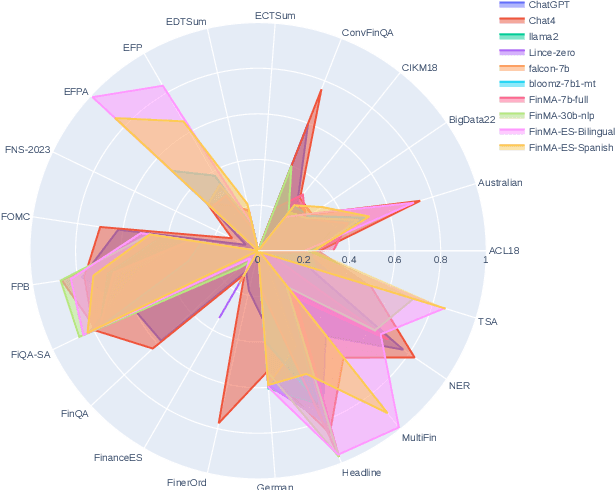
Abstract:Despite Spanish's pivotal role in the global finance industry, a pronounced gap exists in Spanish financial natural language processing (NLP) and application studies compared to English, especially in the era of large language models (LLMs). To bridge this gap, we unveil Tois\'on de Oro, the first bilingual framework that establishes instruction datasets, finetuned LLMs, and evaluation benchmark for financial LLMs in Spanish joint with English. We construct a rigorously curated bilingual instruction dataset including over 144K Spanish and English samples from 15 datasets covering 7 tasks. Harnessing this, we introduce FinMA-ES, an LLM designed for bilingual financial applications. We evaluate our model and existing LLMs using FLARE-ES, the first comprehensive bilingual evaluation benchmark with 21 datasets covering 9 tasks. The FLARE-ES benchmark results reveal a significant multilingual performance gap and bias in existing LLMs. FinMA-ES models surpass SOTA LLMs such as GPT-4 in Spanish financial tasks, due to strategic instruction tuning and leveraging data from diverse linguistic resources, highlighting the positive impact of cross-linguistic transfer. All our datasets, models, and benchmarks have been released.
Empowering Many, Biasing a Few: Generalist Credit Scoring through Large Language Models
Oct 01, 2023



Abstract:Credit and risk assessments are cornerstones of the financial landscape, impacting both individual futures and broader societal constructs. Existing credit scoring models often exhibit limitations stemming from knowledge myopia and task isolation. In response, we formulate three hypotheses and undertake an extensive case study to investigate LLMs' viability in credit assessment. Our empirical investigations unveil LLMs' ability to overcome the limitations inherent in conventional models. We introduce a novel benchmark curated for credit assessment purposes, fine-tune a specialized Credit and Risk Assessment Large Language Model (CALM), and rigorously examine the biases that LLMs may harbor. Our findings underscore LLMs' potential in revolutionizing credit assessment, showcasing their adaptability across diverse financial evaluations, and emphasizing the critical importance of impartial decision-making in the financial sector. Our datasets, models, and benchmarks are open-sourced for other researchers.
PIXIU: A Large Language Model, Instruction Data and Evaluation Benchmark for Finance
Jun 08, 2023
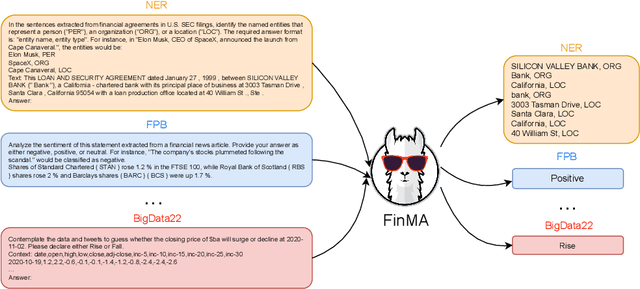

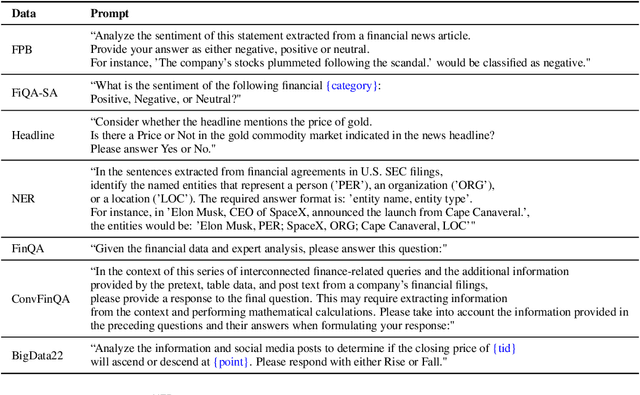
Abstract:Although large language models (LLMs) has shown great performance on natural language processing (NLP) in the financial domain, there are no publicly available financial tailtored LLMs, instruction tuning datasets, and evaluation benchmarks, which is critical for continually pushing forward the open-source development of financial artificial intelligence (AI). This paper introduces PIXIU, a comprehensive framework including the first financial LLM based on fine-tuning LLaMA with instruction data, the first instruction data with 136K data samples to support the fine-tuning, and an evaluation benchmark with 5 tasks and 9 datasets. We first construct the large-scale multi-task instruction data considering a variety of financial tasks, financial document types, and financial data modalities. We then propose a financial LLM called FinMA by fine-tuning LLaMA with the constructed dataset to be able to follow instructions for various financial tasks. To support the evaluation of financial LLMs, we propose a standardized benchmark that covers a set of critical financial tasks, including five financial NLP tasks and one financial prediction task. With this benchmark, we conduct a detailed analysis of FinMA and several existing LLMs, uncovering their strengths and weaknesses in handling critical financial tasks. The model, datasets, benchmark, and experimental results are open-sourced to facilitate future research in financial AI.
Can ChatGPT Forecast Stock Price Movements? Return Predictability and Large Language Models
Apr 22, 2023



Abstract:We examine the potential of ChatGPT, and other large language models, in predicting stock market returns using sentiment analysis of news headlines. We use ChatGPT to indicate whether a given headline is good, bad, or irrelevant news for firms' stock prices. We then compute a numerical score and document a positive correlation between these ChatGPT scores and subsequent daily stock market returns. Further, ChatGPT outperforms traditional sentiment analysis methods. We find that more basic models such as GPT-1, GPT-2, and BERT cannot accurately forecast returns, indicating return predictability is an emerging capacity of complex models. Our results suggest that incorporating advanced language models into the investment decision-making process can yield more accurate predictions and enhance the performance of quantitative trading strategies.
 Add to Chrome
Add to Chrome Add to Firefox
Add to Firefox Add to Edge
Add to Edge